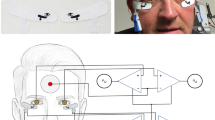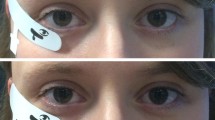Abstract
Pattern electroretinograms are small physiologic signals that require good patient cooperation and long recording times, particularly when conditions are not optimal. Six electrodes were compared to evaluate their efficacy. Pattern electroretinograms were recorded in eight healthy volunteers to high-contrast, pattern-reversal checks (40′ width) with Burian-Allen, DTL fiber, C-glide, gold foil, HK loop and skin electrodes. Raw data for 320 reversals were analyzed off-line to evaluate signal amplitude, quality, P50 and N95 peak times, artifact rate and electrical noise. Insertion time, impedance and subjective comfort were also assessed. The Burian-Allen contact lens electrode gave the largest signal and lowest impedance but was the least comfortable and had the highest artifact rate (p<0.01). A skin electrode on the lower eyelid produced the smallest pattern electroretinogram with the poorest quality (p<0.05). The four other electrodes were foil or fiber electrodes in contact with the tear film, conjunctiva and/or the inferior cornea. The signal from these showed only minor differences. When electrodes are compared for pattern electroretinograms recording, the foil and fiber electrodes do not differ substantially but contact lens and skin electrodes show substantial disadvantages.
Similar content being viewed by others
Abbreviations
- ANOVA:
-
analysis of variance
- PLSD:
-
protected least significant difference
References
Maffei L. Electroretinographic and visual cortical potentials in response to alternating gratings. Ann N Y Acad Sci 1982; 388: 1–9.
Berninger TA, Arden GB. The pattern electroretinogram. Eye 1988; 2 (suppl): S257–83.
Sherman J. Simultaneous pattern-reversal electroretinograms and visual evoked potentials in diseases of the macula and optic nerve. Ann N Y Acad Sci 1982; 388: 214–26.
Celesia GG, Kaufman D, Cone S. Simultaneous recording of pattern electroretinography and visual evoked potentials in multiple sclerosis: a method to separate demyelnation from axonal damage. Arch Neurol 1986; 43: 1247–52.
Hull BM, thompson DA. A review of the clinical applications of the pattern electroretinogram. Ophthalmic Physiol Opt 1989; 9: 143–52.
Bradshaw K. Early onset of abnormality of the pattern-evoked. ERG in patients with optic neuritis. Clin Vision Sci 1992; 4: 313–25.
Bach M, Gerling J, Geiger K. Optic atrophy reduces the pattern-electroretinogram for both fine and coarse stimulus patterns. Clin Vision Sci 1992; 4: 327–33.
Odom JV, Holder GE, Feghali JG, Cavender S. Pattern electroretinogram intrasession reliability: a two center comparison. Clin Vision Sci 1992; 4: 263–81.
Marmor M, Holder GE, Porciatti V, Trick GI, Zrenner E for ISCEV. Guidelines for basic pattern electroretinography: recommendations by the International Society for Clinical Electrophysiology of Vision. Doc Ophthalmol. In press. 1996; 91: 291–298.
Robins J, Turner J. Assessment of various types of electrode in clinical ERG. Impulse 1988; 5: 2–5.
Gjötterberg M. Electrodes for electroretinography: a comparison of four different types. Arch Ophthalmol 1983; 104: 569–70.
Hawlina M, Konec B. New non-corneal ‘HK-loop’ electrode for clinical ERG. Doc Ophthalmol 1992; 81: 253–9.
Eskowitz L, Kriss A, Shawkat F. A comparison of flash electroretinograms recorded from Burian Allen, Jet, C-glide, gold foil, DTL and skin electrodes. Eye 1993; 7: 169–71.
Papakostopoulos D, Barber C, Dean-Hart JC. The sampling properties of different types of ERG electrode. Clin Vision Sci 1993; 8: 481–8.
Hennessy MP, Vaegan. Amplitude scaling relationships of Burian-Allen, gold foil and Dawson, Trick and Litzkow electrodes. Doc Ophthalmol 1995; 89: 235–48.
Kriss A, Jeffrey B, Taylor D. The electroretinogram in infants and children. J Clin Neurophysiol 1992; 9: 373–93.
Coupland SG, Janaky M. ERG electrode in pediatric patients: comparison of DTL fibre, PVA-gel and non-corneal skin electrodes. Doc Ophthalmol 1989; 71: 427–34.
Wali N, Leguire LE. Dark adapted luminance-response functions with skin and corneal electrodes. Doc Ophthalmol 1991; 76: 367–75.
Hawlina M. Pattern electroretinography with the new HK-loop electrode. Chibret Int J Ophthalmol 1993; 9: 51–58.
Prager TC, Saad N, Schweitzer FC, Garcia CA, Arden GB. Electrode comparison in pattern electroretinography. Invest Ophthalmol Vis Sci 1992; 33: 390–4.
Burian HM, Allen L. A speculum contact lens electrode for electroretinography. Electroencephalogr Clin Neurophysiol 1954; 6: 509–11.
Lawill T, Burian HM. A modification of the Burian-Allen contact lens electrode for electroretinography. Am J Ophthalmol 1966; 61: 1506–9.
Barber C. Electrodes and the recording of the human electroretinogram (ERG). Int J Psychophysiol 1994; 16: 131–6.
Dawson WW, Trick GL, Litzkow CA. Improved electrode for electroretinography. Invest Ophthalmol Vis Sci 1979; 18: 988–91.
Arden GB, Carter RM, Hogg C, Siegal IM, Margolis S. A gold foil electrode: extending the horizons for clinical electroretinography. Invest Ophthalmol Vis Sci 1979; 16: 421–6.
Adashi-Usami E, Kuroda N, Nakajima I. Distribution of pattern-evoked potentials in the facial area. Am J Ophthalmol 1983; 96: 734–739.
Peachy NS, Sokol S, Moskowitz A. Recording the contralateral PERG: effect of different electrodes. Invest Ophthalmol Vis Sci 1983; 24: 1514–6.
Seiple WH, Seigel IM. Recording the pattern electroretinogram: a cautionary note. Invest Ophthalmol Vis Sci 1983; 24: 796–798.
Winer BJ. Statistical principals in experimental design. International student edition. Tokyo: McGraw Hill Kogakusha Ltd, 1971: 196–201.
Marmor MF, Zrenner E, for the International Society for Clinical Electrophysiology of Vision. Standard for clinical electroretinography (1994 update). Doc Ophthalmol 1995; 89: 199–210.
Harden A. Non-corneal electroretinogram. Br J Ophthalmol 1974; 58: 811–6.
Hèbert M, Lachapelle P, Dumont M. Reproducibility of electroretinograms recorded with DTL electrodes. Doc Ophthalmol 1996; 91: 333–42.
Prager TC, Fea AM, Sponsel WE, Schweitzer FC, McNulty L, Garcia CA. The gold foil electrode in pattern electroretinography. Doc Ophthalmol 1994; 86: 267–274.
Arden GB, Hogg C, Holder GE. Gold foil electrodes: a two centre study of electrode reliability. Doc Ophthalmol 1994; 86: 275–84.
Vaegan. Electrode standards in electroretinography. Doc Ophthalmol 1996; 92: 243–5.
Author information
Authors and Affiliations
Rights and permissions
About this article
Cite this article
McCulloch, D.L., Van Boemel, G.B. & Borchert, M.S. Comparisons of contact lens, foil, fiber and skin electrodes for patterns electroretinograms. Doc Ophthalmol 94, 327–340 (1997). https://doi.org/10.1007/BF02580858
Accepted:
Issue Date:
DOI: https://doi.org/10.1007/BF02580858




